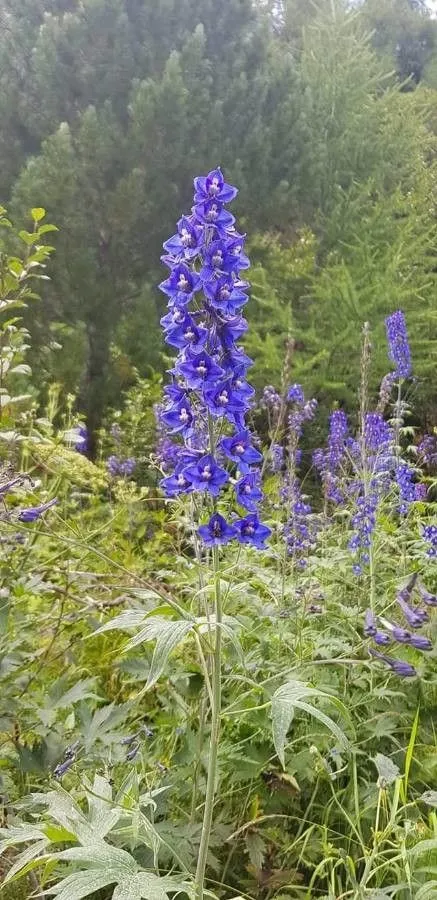
Author: L.
Bibliography: Sp. Pl.: 531 (1753)
Year: 1753
Status: accepted
Rank: species
Genus: Delphinium
Vegetable: False
Observations: European Mts. to Mongolia
Alpine delphinium, a striking member of the Ranunculaceae family, adds a touch of splendor to mountain landscapes with its tall, majestic spikes of flowers. Scientifically known as Delphinium elatum, this plant has captivated botanists and plant enthusiasts since it was first described in 1753.
Native to the mountainous regions stretching from Europe to Mongolia, Alpine delphinium thrives in cool, high-altitude environments where it can often be seen dotting alpine meadows with vivid splashes of color. The plant’s impressive height, often reaching up to six feet, along with its dense clusters of vibrant blue, purple, or even white flowers, makes it a standout in any natural or cultivated setting.
The specific epithet “elatum” aptly translates to “tall,” a nod to the plant’s prominent stature. These flowers, which bloom in the height of summer, are known not only for their beauty but also for their complex structure, featuring a five-lobed calyx and a spur that extends backward, a characteristic trait of the delphinium genus.
Historically, Alpine delphinium has been admired not just for its decorative appeal but also for its place in the rich tapestry of European and Asian flora. Its presence in the wild symbolizes pristine and untouched habitats, often highlighting the ecological importance of conserving these majestic regions.
While stunning in appearance, all parts of Delphinium elatum are toxic if ingested, a characteristic trait shared with other members of the Ranunculaceae family. This toxicity serves as a natural deterrent to herbivores, ensuring the plant’s survival in its native habitats.
Whether gracing a garden or standing tall in its natural mountain home, Alpine delphinium continues to be cherished for its resilience and breathtaking beauty, forever standing as a testament to nature’s remarkable artistry.
Eng: candle larkspur, alpine delphinium, bee larkspur
Lit: didysis pentinius
Deu: hoher rittersporn
Dan: staude-ridderspore, stor ridderspore
Lav: augstais gailpiesis
Por: esporinha-alta, esporinha-gigante
Nno: hageriddarspore
Nob: hageridderspore
Swe: isoritarinkannus, stor riddarsporre
Fin: isoritarinkannus
Fra: pied-d’alouette élevé, dauphinelle élevée
Sme: riddársiekkis
En: Alpine delphinium, Candle larkspur, Alpine Larkspur, Bee larkspur, Candle Delphinium, Larkspur
Ar: عائق خلاب
Az: Hündür mahmızçiçək
Be: Рагулькі высокія
Bg: Висока ралица
Zh: 高翠雀花
Cs: Stračka vyvýšená
Da: Staude-ridderspore, Stor ridderspore
Et: Kõrge kukekannus
Fi: Isoritarinkannus
Fr: Pied-d’alouette élevé, Dauphinelle élevée, Pied d’alouette élevé
De: Hoher Rittersporn
It: Speronella elevata
Lv: Augstais gaiļpiesis, Augstais gailpiesis
Lt: Didysis pentinius
Mk: Обична мамуза
Ml: ഡെൽഫിനിയം ഇലാറ്റം
Se: Riddársiekkis
Nb: Hageridderspore
Nn: Hageriddarspore
Pl: Ostróżka, Ostróżka wyniosła
Pt: Esporinha-alta, Esporinha-gigante
Ru: Živokost vysokaja, Живокость высокая
Es: Espuela de caballero
Sv: Stor riddarsporre, Isoritarinkannus
Taken Jul 18, 2020 by David Blondin (cc-by-sa)
Taken Aug 5, 2019 by korben (cc-by-sa)
Taken Feb 17, 2019 by Jean-Christophe Lombardo (cc-by-sa)
Taken May 30, 2019 by Sylvie Arnaud (cc-by-sa)
Taken Jul 14, 2013 by Annemarie Ahrens-Stehle (cc-by-sa)
Taken Aug 12, 2021 by Dieter Wagner (cc-by-sa)
Taken Jul 20, 2020 by huy HO (cc-by-sa)
Taken Oct 7, 2020 by Walter Bauer (cc-by-sa)
Taken Jun 16, 2021 by Carys Redman-White (cc-by-sa)
Taken Jul 16, 2019 by Julia Günzel (cc-by-sa)
Taken May 20, 2020 by Waber Theres (cc-by-sa)
Taken Jul 23, 2022 by Jacques Zuber (cc-by-sa)
Taken Aug 5, 2022 by ninie ninie (cc-by-sa)
Taken May 11, 2020 by Ha Anna (cc-by-sa)
Taken Jan 8, 2020 by Agata H (cc-by-sa)
Taken Jun 24, 2022 by koert de jong (cc-by-sa)
Taken Jun 23, 2021 by Svenja Str (cc-by-sa)
Taken Jun 27, 2022 by Tristan Jaton-Maria (cc-by-sa)
Taken Jun 27, 2022 by Tristan Jaton-Maria (cc-by-sa)
Taken Aug 14, 2019 by Fastolphc (cc-by-sa)
Taken Sep 8, 2018 by Ferri Angelino (cc-by-sa)
Taken Jan 1, 1800 by Tela Botanica − Thierry Pernot (cc-by-sa)
Taken Jan 1, 1800 by Tela Botanica − Thierry Pernot (cc-by-sa)
Taken Jul 12, 2012 by Tela Botanica − Yoan MARTIN (cc-by-sa)
Taken Aug 17, 2019 by Mateusz hitsug (cc-by-sa)
Taken Aug 15, 2011 by Photoflora – Bernard TILLY (©)
Taken Aug 15, 2011 by Photoflora – Bernard TILLY (©)
Taken Aug 15, 2011 by Photoflora – Bernard TILLY (©)
Taken Jan 1, 1800 by Tela Botanica − Thierry Pernot (cc-by-sa)
Taken Aug 7, 2020 by Rico Mende (cc-by-sa)
© copyright of the Board of Trustees of the Royal Botanic Gardens, Kew.
© copyright of the Board of Trustees of the Royal Botanic Gardens, Kew.
© copyright of the Board of Trustees of the Royal Botanic Gardens, Kew.
Growth habit>: Forb/herb
Ph maximum: 7.5
Ph minimum: 7.0
Light: 6
Atmospheric humidity: 7
Bloom months: [‘jul’, ‘aug’]
Soil nutriments: 7
Family: Myrtaceae Author: (F.Muell.) K.D.Hill & L.A.S.Johnson Bibliography: Telopea 6: 402 (1995) Year: 1995 Status:…
Family: Rubiaceae Author: Pierre ex A.Froehner Bibliography: Notizbl. Bot. Gart. Berlin-Dahlem 1: 237 (1897) Year:…
Family: Sapindaceae Author: Koidz. Bibliography: J. Coll. Sci. Imp. Univ. Tokyo 32(1): 38 (1911) Year:…
Family: Asteraceae Author: A.Gray Bibliography: Pacif. Railr. Rep.: 107 (1857) Year: 1857 Status: accepted Rank:…
Family: Fabaceae Author: Medik. Bibliography: Vorles. Churpfälz. Phys.-Ökon. Ges. 2: 398 (1787) Year: 1787 Status:…
Family: Aspleniaceae Author: (Cav.) Alston Bibliography: Bull. Misc. Inform. Kew 1932: 309 (1932) Year: 1932…